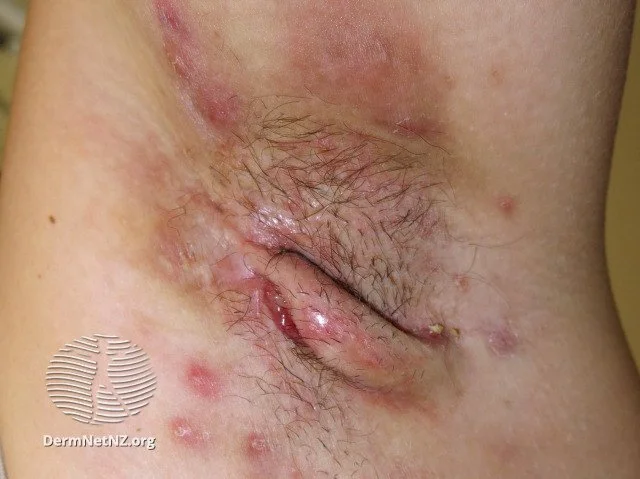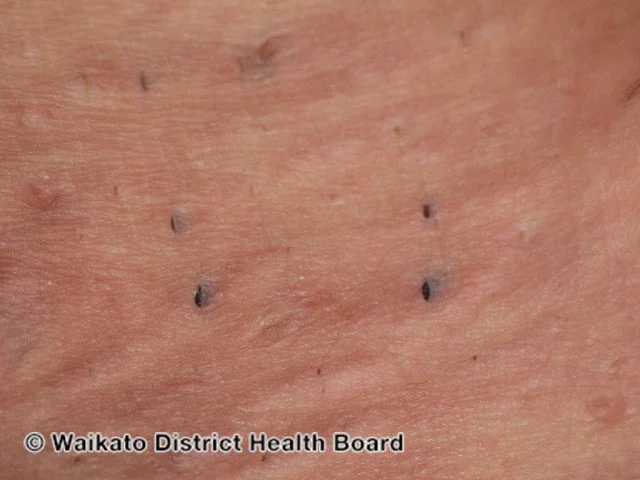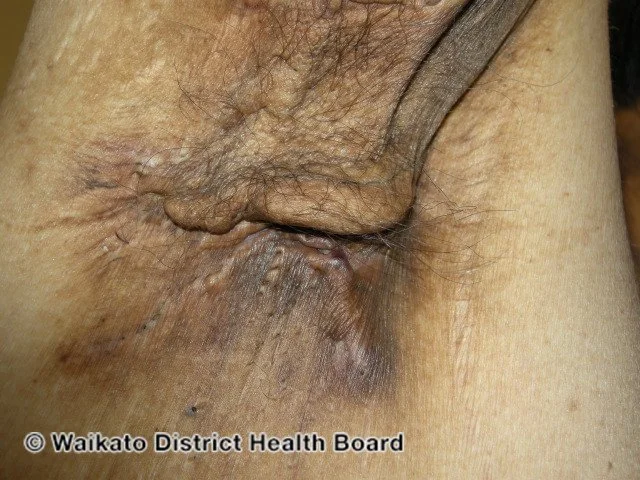
Hidradenitis Suppurativa
An example of hidradenitis suppurativa, which looks like boils, pimples, and scar-tissue tracts in the skin folds.
Credit: DermNet NZ
What is hidradenitis suppurativa?
Hidradenitis suppurativa (HS) is a long-term inflammatory skin condition marked by swollen, painful lumps or abscesses in areas such as the armpits, groin, or underneath the breasts. These lumps can rupture, releasing fluid or pus. The condition is recurring, often leading to persistent wounds and scar formation. While HS typically stays localized, there's potential for it to spread. Apart from physical discomfort, HS considerably affects emotional well-being, with many sufferers grappling with depression and anxiety.
What causes hidradenitis suppurativa?
The exact origins of HS remain undetermined, but it's postulated as an inflammatory condition influenced by genetic and environmental factors. Since lesions commonly appear near hair follicles, theories often point towards excessive sweating or hair follicle dysfunction as potential culprits. Known triggers or risk factors for HS encompass:
Hormonal Factors: Predominantly affecting women.
Obesity: A significant contributing factor.
Family History: Having relatives with HS increases risk.
Smoking: Raises susceptibility.
Clothing and Friction: Tight garments and chafing from skin folds.
Shaving: Particularly in the affected areas.
Autoimmune Disorders: Like inflammatory bowel disease.
Certain Medications.
Climatic Factors: Hot and humid weather can exacerbate symptoms.
What are the symptoms of hidradenitis suppurativa?
HS can manifest in isolated or multiple areas. Common sites are the armpits, neck, beneath the breasts, inner thighs, as well as genital areas. Typical symptoms include:
Tender, hard lumps and larger nodules.
Lesions filled with fluid or pus.
Clogged and open hair follicles.
Scarring across multiple regions.
How do I treat hidradenitis suppurativa?
Effective management of HS entails prevention, self-care, and lifestyle modifications, but medical intervention is often imperative. Potential treatments include:
Medications:
Antibiotics (oral forms like rifampicin/clindamycin, dapsone and topical clindamycin).
Hormonal treatments (birth control pills, spironolactone, finasteride).
Steroids (both injectable and oral forms for acute flare-ups).
Diabetes drug, Metformin.
Acne medication, Isotretinoin.
Immune-regulating drugs (methotrexate, cyclosporine, azathioprine).
Biologic treatments (adalimumab, infliximab, secukinumab, and JAK inhibitors).
Surgical Options:
Draining of acute abscesses.
Curettage and de-roofing of nodules, abscesses and sinuses
Laser ablation of nodules, abscesses and sinuses
Surgical excision for persistent nodules.
Laser hair removal, though typically not insured.
How do I prevent hidradenitis suppurativa?
Medication might be necessary for flare prevention, but individuals can also:
Adopt a healthy weight.
Embrace an anti-inflammatory, plant-based diet low in sugars, grains, and dairy.
Cease smoking.
Choose loose clothing.
Use fragrance-free antiperspirants daily.
Maintain hygiene through antiseptic washes or bleach baths.
Opt for warm baths to soothe affected areas.
HS can cause comedones (clogged pores) in the affected areas - this is very characteristic.
Credit: DermNet NZ
The scarring in hidradenitis suppurativa can be severe.
Credit: DermNet NZ



